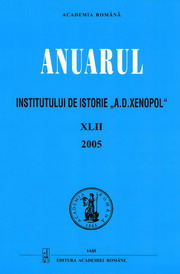CURȚILE DOMNEȘTI DE LA BOTOȘANI. CONTRIBUȚII LA ISTORIA ORAȘULUI ȘI LA STABILIREA UNEI NOI ATESTĂRI DOCUMENTARE A ACESTUIA
PRINCELY COURTS OF BOTOȘANI. CONTRIBUTIONS TO THE HISTORY OF THE CITY AND THE ESTABLISHMENT OF NEW DOCUMENTARY ATTESTATION
Author(s): Luca DiaconuSubject(s): History
Published by: Editura Academiei Române
Keywords: princely courts; city of Botoșani; archaeological testimonies; religious documents
Summary/Abstract: This paper reviews the hypothesis relating to the topic of the princely courts of Botoșani. The lack of direct internal historical documents made it necessary to resort to political-economic testimonies from the period of Petru I, of Alexandru cel Bun and of his successors. Thus, by outlining the importance of the strategic commercial role the city of Botoșani played, compared to other neighbouring cities, placed on the Moldavian trade road as well, which were attested with documents before 1400, the privileged place of the city of Botoșani at the intersection of two international roads was highlighted, indicating an earlier existence than the towns of Hârlău and Dorohoi – cities benefitting from older attestations. documentary Then, by reassessing the oldest religious documents of the Armenians from Poland and Moldavia, who in their capacity of renowned merchants, settled down from the very beginning in this town, a new documentary attestation of the city of Botoşani was reached, established for 18 August 1388: the date of the Gramata of Catholicos Theodoros II, when according to some external researches, the name of the town of Botoșani is mentioned among other settlements. By this last attestation, the hypothesis of its existence as a town before the creation of the Moldavia state is supported, against the interpretation of the old documentary attestation of 1439, when the Tartars burnt down Botoșani and at the same time that of the possible foundation, in this place, of the princely courts by Alexandru cel Bun. Finally, by using new documents, a new documentary attestation of these courts was established for the date of 15 March 1601, as well as of the first princely priest, serving at the princely church of Popăuţi, put forward for the year of 1608. And on the other hand, on the basis of the indirect documents issued from Botoşani by Petru Rareş, since the second year of his rule, one can support the existence and the functioning of these courts starting with the first half of the 16th century. At the same time, the archaeological testimonies attesting their existence and location are also confirmed by the vornic [governor] of Botoşani, Nurod, buried and discovered at the necropolis of Popăuţi; as well as the probability of the voivode foundation here, as a princely church for the court residence of Botoşani.
Journal: Anuarul Institutului de Istorie »A.D. Xenopol« - Iaşi
- Issue Year: LII/2015
- Issue No: Supl.
- Page Range: 1-42
- Page Count: 42
- Language: Romanian

